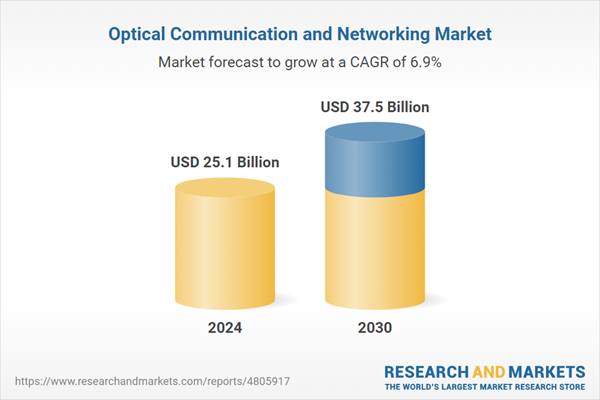The global market for Optical Communication and Networking was valued at US$25.1 Billion in 2024 and is projected to reach US$37.5 Billion by 2030, growing at a CAGR of 6.9% from 2024 to 2030. This comprehensive report provides an in-depth analysis of market trends, drivers, and forecasts, helping you make informed business decisions. The report includes the most recent global tariff developments and how they impact the Optical Communication and Networking market.
Segments: Component (Switch, Splitter, Amplifier, Circulator, Transceiver, Fiber, Other Components); Application (Data Center, Telecom, Enterprise).
Geographic Regions/Countries: World; United States; Canada; Japan; China; Europe (France; Germany; Italy; United Kingdom; and Rest of Europe); Asia-Pacific; Rest of World.
The analysts continuously track trade developments worldwide, drawing insights from leading global economists and over 200 industry and policy institutions, including think tanks, trade organizations, and national economic advisory bodies. This intelligence is integrated into forecasting models to provide timely, data-driven analysis of emerging risks and opportunities.
Global Optical Communication and Networking Market - Key Trends & Drivers Summarized
How Is Optical Communication and Networking Shaping the Future of Telecommunications?
Optical communication and networking have become the backbone of modern telecommunications, enabling high-speed data transmission over long distances with minimal signal loss. Optical communication relies on light, typically transmitted through fiber optic cables, to carry vast amounts of data at incredibly high speeds, making it essential for everything from internet services to cloud computing and data centers. The growing demand for bandwidth, driven by the increasing consumption of video streaming, cloud services, and 5G technology, has made optical communication systems critical for maintaining network performance and scalability. Fiber optic technology is also more energy-efficient and reliable compared to traditional copper-based networks, which makes it an attractive solution for telecom operators and enterprises looking to future-proof their networks.What Trends Are Driving the Optical Communication and Networking Market?
Several key trends are shaping the optical communication and networking market, primarily driven by the increasing demand for high-speed internet and data services. The rollout of 5G networks is a major trend, as telecom operators are investing heavily in fiber optic infrastructure to support the massive bandwidth and low-latency requirements of 5G services. The rise of cloud computing and data centers is another significant trend, with hyperscale data centers relying on optical communication networks to manage the growing volume of data generated by businesses and consumers. Additionally, the expansion of fiber-to-the-home (FTTH) services is gaining traction, as consumers demand faster, more reliable internet connections for activities such as streaming, gaming, and remote work. Another important trend is the adoption of wavelength division multiplexing (WDM) technology, which enables multiple data signals to be transmitted simultaneously over a single fiber, dramatically increasing the capacity of optical networks.How Is Technology Advancing Optical Communication and Networking?
Technological advancements are at the core of the optical communication and networking market, improving speed, capacity, and reliability. Wavelength division multiplexing (WDM) is a key technology that has revolutionized optical networks by allowing multiple data channels to be transmitted over a single fiber, significantly increasing bandwidth without the need for additional infrastructure. The development of coherent optical technology, which uses advanced modulation formats and signal processing, is enabling faster data transmission rates and longer transmission distances without degradation in signal quality. Advances in fiber optic materials and manufacturing processes are also improving the durability and performance of fiber optic cables, reducing signal loss and increasing transmission distances. Additionally, software-defined networking (SDN) and network function virtualization (NFV) are being integrated with optical networks to enable more flexible, programmable, and automated network management, helping service providers optimize performance and reduce operational costs.What Is Driving the Growth in the Optical Communication and Networking Market?
The growth in the optical communication and networking market is driven by several key factors. The increasing demand for high-speed internet and data services, particularly with the rise of 5G, is one of the primary drivers, as optical networks are essential for handling the large volumes of data and low-latency requirements of next-generation telecommunications. The growing adoption of cloud computing and the expansion of data centers are also fueling demand for high-capacity optical networks to support data storage, processing, and transmission. Fiber-to-the-home (FTTH) deployments are accelerating, driven by consumer demand for faster internet speeds and more reliable connectivity, particularly in the context of remote work and digital entertainment. Additionally, technological innovations such as WDM and coherent optical technology are enabling service providers to expand network capacity and improve performance without significant infrastructure investments, further supporting market growth.Report Scope
The report analyzes the Optical Communication and Networking market, presented in terms of units. The analysis covers the key segments and geographic regions outlined below.Segments: Component (Switch, Splitter, Amplifier, Circulator, Transceiver, Fiber, Other Components); Application (Data Center, Telecom, Enterprise).
Geographic Regions/Countries: World; United States; Canada; Japan; China; Europe (France; Germany; Italy; United Kingdom; and Rest of Europe); Asia-Pacific; Rest of World.
Key Insights:
- Market Growth: Understand the significant growth trajectory of the Switch segment, which is expected to reach US$9.1 Billion by 2030 with a CAGR of a 6.9%. The Splitter segment is also set to grow at 5.3% CAGR over the analysis period.
- Regional Analysis: Gain insights into the U.S. market, valued at $6.9 Billion in 2024, and China, forecasted to grow at an impressive 6.4% CAGR to reach $5.8 Billion by 2030. Discover growth trends in other key regions, including Japan, Canada, Germany, and the Asia-Pacific.
Why You Should Buy This Report:
- Detailed Market Analysis: Access a thorough analysis of the Global Optical Communication and Networking Market, covering all major geographic regions and market segments.
- Competitive Insights: Get an overview of the competitive landscape, including the market presence of major players across different geographies.
- Future Trends and Drivers: Understand the key trends and drivers shaping the future of the Global Optical Communication and Networking Market.
- Actionable Insights: Benefit from actionable insights that can help you identify new revenue opportunities and make strategic business decisions.
Key Questions Answered:
- How is the Global Optical Communication and Networking Market expected to evolve by 2030?
- What are the main drivers and restraints affecting the market?
- Which market segments will grow the most over the forecast period?
- How will market shares for different regions and segments change by 2030?
- Who are the leading players in the market, and what are their prospects?
Report Features:
- Comprehensive Market Data: Independent analysis of annual sales and market forecasts in US$ Million from 2024 to 2030.
- In-Depth Regional Analysis: Detailed insights into key markets, including the U.S., China, Japan, Canada, Europe, Asia-Pacific, Latin America, Middle East, and Africa.
- Company Profiles: Coverage of players such as 2test, A2Bfiber, Adamant Namiki Precision Jewel Co., Ltd., Adva Optical Networking SE, AiroComm and more.
- Complimentary Updates: Receive free report updates for one year to keep you informed of the latest market developments.
Some of the 41 companies featured in this Optical Communication and Networking market report include:
- 2test
- A2Bfiber
- Adamant Namiki Precision Jewel Co., Ltd.
- Adva Optical Networking SE
- AiroComm
- Algety Telecom
- ALPhANOV - Centre technologique optique et lasers
- Alphion Corporation
- Alta Marketing
- ANYK
Tariff Impact Analysis: Key Insights for 2025
Global tariff negotiations across 180+ countries are reshaping supply chains, costs, and competitiveness. This report reflects the latest developments as of April 2025 and incorporates forward-looking insights into the market outlook.The analysts continuously track trade developments worldwide, drawing insights from leading global economists and over 200 industry and policy institutions, including think tanks, trade organizations, and national economic advisory bodies. This intelligence is integrated into forecasting models to provide timely, data-driven analysis of emerging risks and opportunities.
What’s Included in This Edition:
- Tariff-adjusted market forecasts by region and segment
- Analysis of cost and supply chain implications by sourcing and trade exposure
- Strategic insights into geographic shifts
Buyers receive a free July 2025 update with:
- Finalized tariff impacts and new trade agreement effects
- Updated projections reflecting global sourcing and cost shifts
- Expanded country-specific coverage across the industry
Table of Contents
I. METHODOLOGYII. EXECUTIVE SUMMARY2. FOCUS ON SELECT PLAYERSIII. MARKET ANALYSISIV. COMPETITION
1. MARKET OVERVIEW
3. MARKET TRENDS & DRIVERS
4. GLOBAL MARKET PERSPECTIVE
UNITED STATES
CANADA
JAPAN
CHINA
EUROPE
FRANCE
GERMANY
ITALY
UNITED KINGDOM
REST OF EUROPE
ASIA-PACIFIC
REST OF WORLD
Companies Mentioned (Partial List)
A selection of companies mentioned in this report includes, but is not limited to:
- 2test
- A2Bfiber
- Adamant Namiki Precision Jewel Co., Ltd.
- Adva Optical Networking SE
- AiroComm
- Algety Telecom
- ALPhANOV - Centre technologique optique et lasers
- Alphion Corporation
- Alta Marketing
- ANYK
Table Information
| Report Attribute | Details |
|---|---|
| No. of Pages | 194 |
| Published | April 2025 |
| Forecast Period | 2024 - 2030 |
| Estimated Market Value ( USD | $ 25.1 Billion |
| Forecasted Market Value ( USD | $ 37.5 Billion |
| Compound Annual Growth Rate | 6.9% |
| Regions Covered | Global |









